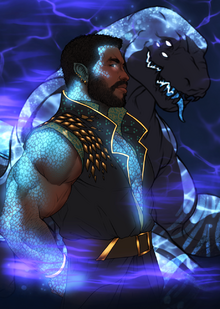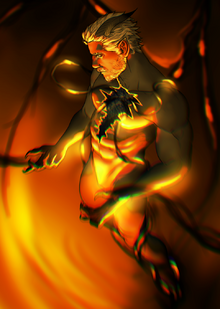Pagan Cults: Difference between revisions
mNo edit summary |
mNo edit summary |
||
| Line 1: | Line 1: | ||
Pagan Faiths is not one consolidated | Pagan Faiths is not one consolidated [[Religion]], but rather a small collection of living monotheistic Religions that pre-date [[Ailor]] civilized status. This means that these religions date back to the days of tribal Ailor kingdoms in the [[Regalian Archipelago]], as well as Religions that pre-date [[Fornoss]] as a faith from [[Ceardia|Oldtera]] before the [[Destruction of Old Ceardia|Destruction]]. The page will highlight important background for the continued worship of these still living gods, as well as how they connect to the modern world despite being so ancient. Characters are able to worship as part of these Religions, and gain specific traits or powers from them in connection with the [[Proficiency|Proficiency System]]. These faiths are also able to create [[Godborn]]. | ||
* ''For more on Aloria’s Dead Faiths, Pagan Faiths which lack the powers of their gods, read [[Dead Faiths|this Expanded Lore]]'' | |||
==Xeradon's Will== | ==Xeradon's Will== | ||
<table style="width: 100%;"><tr><td style="width: 33%; vertical-align: top; text-align: left;"> | <table style="width: 100%;"><tr><td style="width: 33%; vertical-align: top; text-align: left;"> | ||
| Line 11: | Line 12: | ||
Xeradon is the only currently known Pagan God that also produces Godborn called the Deep Ones. However, information on the Deep Ones is rarely known outside of their own religious circles, because Xeradon's will is already an obscure Cult religion, and because its members deign land-walkers to be too inferior of mind and comprehension to behold Xeradon's true glory. Even if Xeradon walked in Regalia, the faithful would suppress their urge to praise and worship him, and work with him instead as if he were their stern father, because none should be alerted of his true identity. Occasionally however, when Xeradon's faithful have established some sort of social rapport (read: feel their social contacts are pet-like/subordinate enough to them that they would not spread the word), they will inform them of the glory of Xeradon in the hopes of converting them. This usually goes paired with a longer running attempt to either magically mutate them to allow them to breathe underwater, or attain some part-aquatic Racial distinction to allow them to swim underwater with them. | Xeradon is the only currently known Pagan God that also produces Godborn called the Deep Ones. However, information on the Deep Ones is rarely known outside of their own religious circles, because Xeradon's will is already an obscure Cult religion, and because its members deign land-walkers to be too inferior of mind and comprehension to behold Xeradon's true glory. Even if Xeradon walked in Regalia, the faithful would suppress their urge to praise and worship him, and work with him instead as if he were their stern father, because none should be alerted of his true identity. Occasionally however, when Xeradon's faithful have established some sort of social rapport (read: feel their social contacts are pet-like/subordinate enough to them that they would not spread the word), they will inform them of the glory of Xeradon in the hopes of converting them. This usually goes paired with a longer running attempt to either magically mutate them to allow them to breathe underwater, or attain some part-aquatic Racial distinction to allow them to swim underwater with them. | ||
|} | |} | ||
==Eldertide Cult== | ==Eldertide Cult== | ||
<table style="width: 100%;"><tr><td style="width: 33%; vertical-align: top; text-align: left;"> | <table style="width: 100%;"><tr><td style="width: 33%; vertical-align: top; text-align: left;"> | ||
| Line 20: | Line 22: | ||
The Eldertide Cult is one of monsters. It is not a traditional religion with an afterlife and a code of conduct, but rather a single ideological belief: the Eldertide is truth and divinity and freedom all at once, and the world is full of monsters. All people, ideas, philosophies, systems and concepts are monstrous and in hiding of their corrupt truth. Only the Eldertide and its children appear as they are in honesty, revealing the ugly truth of the world in the physical, and relishing in it. The Cultists seek to return to the loving arms of the Eldertide in their dreams, while its children roam the world either as wretched and hated outcast, or as truthteller that reveals the rot in the wide world for all to see. Some are brazen in their monstrous appearance and consider it true beauty, while others try to hide their status and fit into society as best as possible. Many of them end up hunted by the Lothar and other anti-Monster forces. The exact nature of the Eldertide is not known, some have speculated that it is a Demon, though its coloration is distinctly orange, and has never seemingly cast any kind of Magic besides the creation of its astral reality. The Eldertide is feared wide and far, because its visitation on good and pious Estelley and Unionist homes usually is followed by family drama and misery, as the true allegiances of one of the family members are revealed in due time, breaking the family apart. As a result, the Eldertide is sometimes also called the Homewrecker, a term that is commonly used in vernacular to deride adulterers who lead themselves and others astray. | The Eldertide Cult is one of monsters. It is not a traditional religion with an afterlife and a code of conduct, but rather a single ideological belief: the Eldertide is truth and divinity and freedom all at once, and the world is full of monsters. All people, ideas, philosophies, systems and concepts are monstrous and in hiding of their corrupt truth. Only the Eldertide and its children appear as they are in honesty, revealing the ugly truth of the world in the physical, and relishing in it. The Cultists seek to return to the loving arms of the Eldertide in their dreams, while its children roam the world either as wretched and hated outcast, or as truthteller that reveals the rot in the wide world for all to see. Some are brazen in their monstrous appearance and consider it true beauty, while others try to hide their status and fit into society as best as possible. Many of them end up hunted by the Lothar and other anti-Monster forces. The exact nature of the Eldertide is not known, some have speculated that it is a Demon, though its coloration is distinctly orange, and has never seemingly cast any kind of Magic besides the creation of its astral reality. The Eldertide is feared wide and far, because its visitation on good and pious Estelley and Unionist homes usually is followed by family drama and misery, as the true allegiances of one of the family members are revealed in due time, breaking the family apart. As a result, the Eldertide is sometimes also called the Homewrecker, a term that is commonly used in vernacular to deride adulterers who lead themselves and others astray. | ||
|} | |} | ||
==The Blood Covenant== | ==The Blood Covenant== | ||
<table style="width: 100%;"><tr><td style="width: 33%; vertical-align: top; text-align: left;"> | <table style="width: 100%;"><tr><td style="width: 33%; vertical-align: top; text-align: left;"> | ||
| Line 52: | Line 33: | ||
The central command of the Blood Covenant is to consume the Rotten Blood, as to fight the "encroachment of all that is golden", but also to avenge the event called the Bloodrot (though it remains somewhat unclear what this means, it just instills a dislike of Old Gods worshipers). The encroachment of all that is golden appears more like an analogy against the march of progress, in essence: fighting against anti-[[Magic]] sentiments, fighting against colonization, fighting against the eradication of tribal or uncivilized societies by centralized states, fighting for the autonomy of culturally dissonant regions, and having an intense hatred for lies, deceit, and falsehoods. Worship of the Blood Covenant is done by sacrificing animals (and sometimes, people), and consuming their heart before going on the hunt, with the hunt being either literal, or figurative for an enemy. | The central command of the Blood Covenant is to consume the Rotten Blood, as to fight the "encroachment of all that is golden", but also to avenge the event called the Bloodrot (though it remains somewhat unclear what this means, it just instills a dislike of Old Gods worshipers). The encroachment of all that is golden appears more like an analogy against the march of progress, in essence: fighting against anti-[[Magic]] sentiments, fighting against colonization, fighting against the eradication of tribal or uncivilized societies by centralized states, fighting for the autonomy of culturally dissonant regions, and having an intense hatred for lies, deceit, and falsehoods. Worship of the Blood Covenant is done by sacrificing animals (and sometimes, people), and consuming their heart before going on the hunt, with the hunt being either literal, or figurative for an enemy. | ||
|} | |} | ||
==Trivia== | ==Trivia== | ||
* Pagan within the canon universe refers to religions pre-dating Unionism. While this technically also includes Fornoss from the perspective of the Ailor, because Fornoss is such a large and populous religion in the modern era, it is not included in classical categorization, even if some Fornoss worshipers refer to themselves as "The Pagan". | * Pagan within the canon universe refers to religions pre-dating Unionism. While this technically also includes Fornoss from the perspective of the Ailor, because Fornoss is such a large and populous religion in the modern era, it is not included in classical categorization, even if some Fornoss worshipers refer to themselves as "The Pagan". | ||
* Not all Pagan religions were Monotheistic, but in general the majority of them are, and at least all the Pagan religions that are well known or to some degree understood and still around. Why Ailor religions suddenly swapped from | * Not all Pagan religions were Monotheistic, but in general the majority of them are, and at least all the Pagan religions that are well known or to some degree understood and still around. Why Ailor religions suddenly swapped from monotheistic to polytheistic is unknown, though it is speculated to have been related to a widening of perspective on the world from only regional awareness, to global awareness. | ||
{{Religion}} | {{Religion}} | ||
[[category:Religion]] [[category:Human Religions]] | [[category:Religion]] [[category:Human Religions]] | ||
Revision as of 15:51, 2 December 2023
Pagan Faiths is not one consolidated Religion, but rather a small collection of living monotheistic Religions that pre-date Ailor civilized status. This means that these religions date back to the days of tribal Ailor kingdoms in the Regalian Archipelago, as well as Religions that pre-date Fornoss as a faith from Oldtera before the Destruction. The page will highlight important background for the continued worship of these still living gods, as well as how they connect to the modern world despite being so ancient. Characters are able to worship as part of these Religions, and gain specific traits or powers from them in connection with the Proficiency System. These faiths are also able to create Godborn.
- For more on Aloria’s Dead Faiths, Pagan Faiths which lack the powers of their gods, read this Expanded Lore
Xeradon's Will
Eldertide Cult
| ||||||||||||||||


